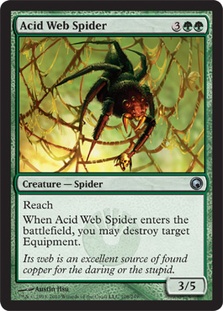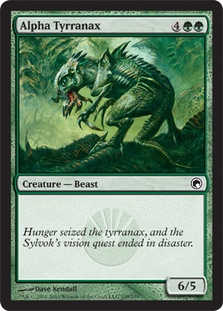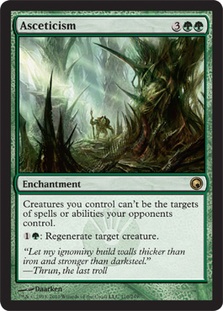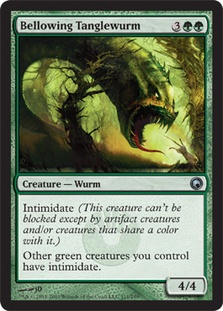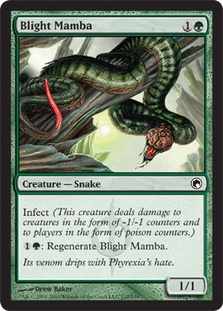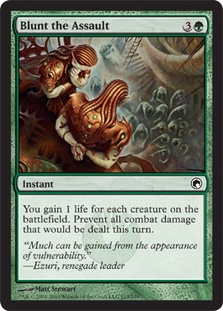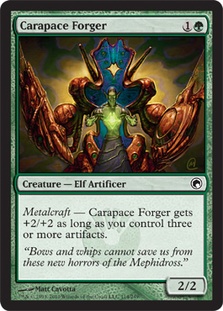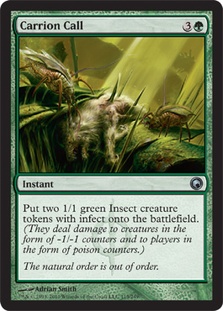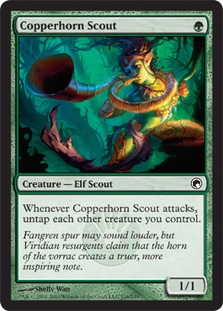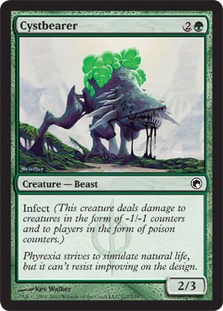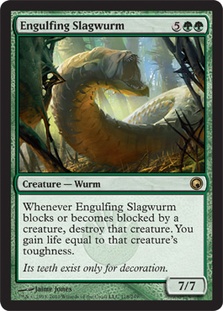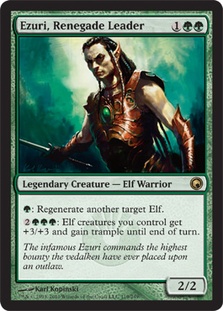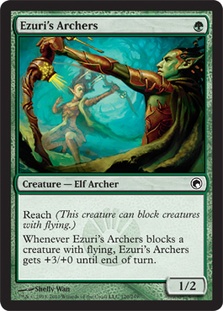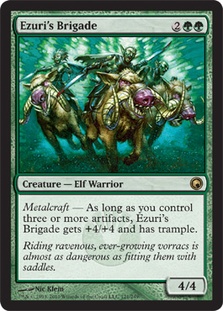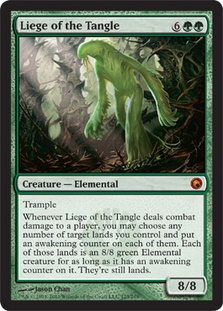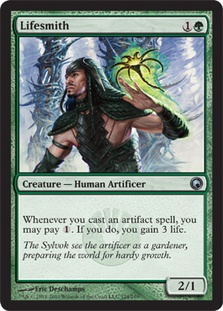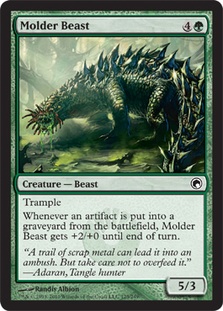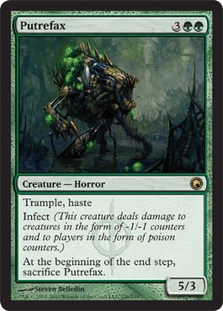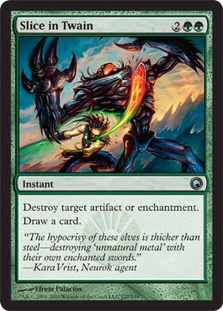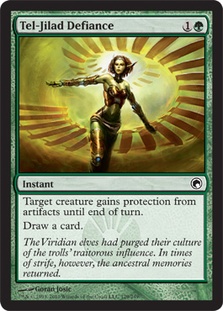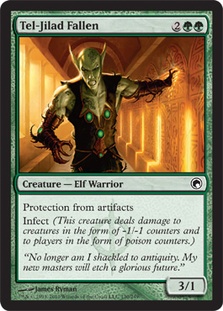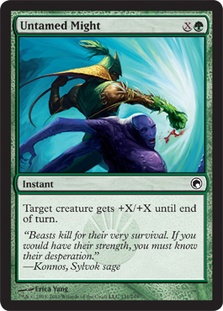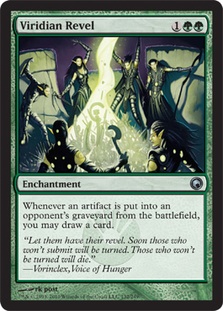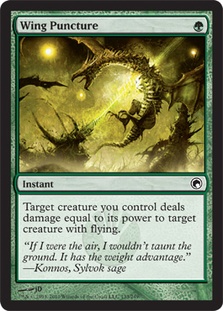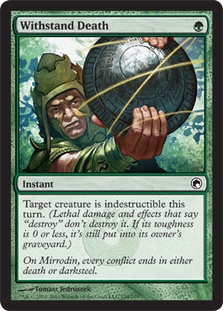As usual most of green is spent thinking of ways to prevent all the cards that are more or less “Beast!” from blurring together. It’s with the ones that are willing to step outside that paradigm and work with the enemy where green can hope to do something worthwhile. You can thank the renegade leader later.
It has the decency to ignore that which it cannot use.
A version with similar statistics but lacking reach was serviceable enough but was also able to hit a vastly wider array of targets. This only hits equipment and that’s far too narrow for an incremental card. If I’m going to go there I want to blow them away.
What do you call a Beta Tyrranax? Dead.
I appreciate that we’re no longer attaching tiny little abilities to creatures that don’t need them to fulfill their purpose in life. It saves us all so much trouble.
A true ascetic couldn’t afford it.
This is overpriced but could it occasionally be the right tool for the right job? There are going to be a lot of decks that fall apart when your creatures can’t be targeted and they can’t be beaten in a fight. Even Day of Judgment allows regeneration. If playing this invalidates the opponent’s entire strategy and you have enough time to invest in it this could end up being a sleeper sideboard card no matter how terrible a deal it might seem to be. Combining this with Vengevine is especially scary leaving decks that don’t have bigger creatures or graveyard hate with essentially no answers.
Like we’ve never seen tangled up in green.
It’s not hard to assemble a deck full of green creatures at which point about half of your opponents will be completely shut out of blocking on the spot. That’s not the type of effect that’s worth spending cards on but the cost of the effect is only about two mana. At that price I’m highly interested especially as a sideboard card since often this will either not have creatures to plow through or you’ll be up against little green men or potentially artifacts. Being able to seamlessly go through the enemy’s defenses will win a lot of games and as Magic moves more and more into an equilibrium of creature combat this type of ability becomes more valuable.
Your mamba’s so blighted when she attacks you get an earned income tax credit.
The fact that Blight Mamba can wear down enemy troops over time while regenerating is nice and it’s certainly miles better than the other two-drops. That makes this more or less mandatory for anyone looking to play with poison who’s willing to go into green no matter how ugly it looks.
Call me object. Mr. Object.
While three mana is a ton to pay for the extra life points the effect could be exactly what this sort of deck wants as it buys more than a full turn against creature decks at the cost of only one card. It does make it hard to cast anything else in the meantime but as a supplementary stalling tactic it might play far better than it reads.
Appreciating the fine arts or the ancient masters is a lifelong quest. Smashing things with them is much easier.
This is an extremely solid way to leverage a high artifact count. If you fail it’s a creature that’s poor but still useful and if it succeeds it becomes highly efficient. The break-even point is when this is large about half the time. The risk is creating a deck that has large but beatable creatures when metalcraft is active – but is poor and unlikely to beat much of anything when metalcraft is inactive. The details of how things come together will be important and the next set will make or break the strategy.
Why do you charge for bags?
The numbers here don’t add up; although it might be reasonable at as little as one mana cheaper. This is the type of set where that’s not so bad.
Nothing opens the eye and gets everyone on their feet like watching someone get slaughtered.
Vigilance for the team is cute but essentially trivial. The only way this gets interesting is if you’re untapping mana creatures so they can double cast or otherwise using their abilities but there are far too many ways for that plan to not work. It involves over-committing to the board; it means playing too many cheap enablers and this is liable to get eaten for lunch the moment it tries to turn sideways.
You won’t have to bear it much longer.
This seems to be standard issue for the infect curve: a bad creature in every context except for killing an opponent with poison counters. In that context it kills in five hits which still isn’t impressive. One might be forced to play this to round out the creature set but it’s something to be avoided.
You’d be well advised not to mess with one if such a thing were possible.
There’s no profitable block of Engulfing Slagwurm but there’s always the classic “throw a regenerator or token in the way” with only minor life gain as a side effect and in general the resulting clock is slow. Meanwhile any noncombat solution to this problem is going to work without any collateral damage. It’s a solid ground defender but I’m not paying seven mana for that.
He calls himself a renegade but all I ever hear from him is “Smash them” and then “We eat!”
Telegraphing that you’re going to kill your opponent can be problematic especially given that Ezuri cannot protect himself but being able to have another creature to boost and having something to do in the meantime – such as regenerate anyone else on the team or even attack for two – is a huge advantage not to mention having the ability to do this more than once.
Besides if telegraphing that you’re going to kill your opponent is your biggest problem with your three drop you’re probably doing something right. He can attack on his own for five without it needing to be a big production even if the big production would be preferred and occasionally he’ll help a ragtag army hold the ground while it builds up the necessary numbers and mana to strike back for a one-shot kill. With both Arbor Elf and Llanowar Elf available to jumpstart the process there’s a lot to like here. There are curve issues as he clashes with various more traditional lords for that space but he also plays very well with Elvish Archdruid and adds a lot of flexibility to what would otherwise be a straightforward deck with little staying power.
What goes up is a lot more effective before it comes down.
This is a specialized creature with a specialized purpose and unfortunately that purpose is blocking. Blocking is not a good purpose and there’s a reason people are debating whether this is Limited playable rather than whether it is Constructed playable.
You go to war with the army you have. Sometimes it is even the army you want.
Now we’re talking payoff! Getting an 8/8 trampler for four mana is a lot of added value; this gives you enough time to get metalcraft ready before the attack and the fallback position isn’t great but is situationally serviceable. Together with Carapace Forger that’s eight excellent creatures to round out a metalcraft deck which can then be supplemented by any number of other strategies.
We will invent a brilliant device of terrifying power capable of modifying entire worlds to our every whim no matter what lies in our way. Then we will forget about this device and never speak of it again.
The eternal question for cards like this will always be: What is X? Obviously if X isn’t at least three then there’s no point. At three this seems worse than traditional card drawing unless it involves a ton of setup and even then the numbers max out at three and there will be plenty of cards that cause you to miss. At four or more it starts to be better than card drawing if the rest of the deck is setup that way but I’d still rather have a large creature than try to force something like this to happen.
Tangled up is you.
This kills the opponent in two turns if it isn’t dealt with and does so while providing strong ground defense. That’s the good news. The bad news is that it doesn’t punish removal if they get there right away and to get the full effect you have to expose your lands to mass removal. What sinks from having its uses on more than an extreme margin is that the opponents you need to activate your lands against are exactly those that can outright block the Liege when it tries to activate.
“What good is our work if life serves it rather than it serving life?”
Three life a shot can add up fast but not generally in the same decks that want a fighting two-drop. In the matchups you most want the life Lifesmith will probably wind up dead quickly. Life gain only works when it’s built into cards that are naturally what you otherwise want in the places where you need life gain or alternatively when they do nothing other than offer a metric ton of life points at reasonable prices.
There’s only one thing worth molding a beast into.
Green decks with a lot of artifacts are going to want to preserve metalcraft which will limit the number of artifacts that can profitably be sacrificed – even if there’s a good way to do so en masse – and will also discourage the deck from playing such a method. That’s where the power of this card potentially lies so it’s going to be tough to tap into that power. Going after enemy artifacts to try to hit for seven or nine isn’t good enough without a lot of help.
And you wonder why those machines are out of favor.
Five poison counters is half of what it takes to win and the existence of this card makes dealing with poison counters considerably riskier. If the rest of a poison deck could be made to work this would be a good reason to play it but I have no idea where the rest of this deck is going to come from. Without the rest of the deck this is a rude shock that doesn’t accomplish anything. I’m not interested until there’s a good chance doing this on turn five (or better four) will end the game.
Why don’t you just shoot it?
This doesn’t cycle without a target and that removes a lot of the incentive to pay more. When Naturalize effects work you’re ecstatic to have them (I can change with the times people! They’re not Disenchant effects anymore! Wait did I ruin it there?) but when they’re dead they’re outright dead. Especially now with metalcraft it’s important to be able to do this at instant speed; at this cost saving enough mana is going to be tough and more than a little telegraphed. There are worse ways to get artifact removal but this isn’t a particularly good one.
The tangle angler has the pellet with the poison. The creature with the counter has the crew that is blue.
I don’t know what angle he’s looking to tangle but if he wants me to tangle he’s more likely to tangle himself up trying to figure out whether he’s a defender an attacker or a poisoner. He’s not good at any of those jobs.
There comes a time for each of us to lie down in front of the bulldozers but it won’t save our house for long.
Narrow reactive cards are a tough sell to begin with and this is even narrower than usual. It only lasts for one turn and most artifacts are either creatures – in which case this is a combat trick that’s underpowered even for combat tricks – or they tend to be continuous effects. When they’re neither they often destroy classes of cards in ways that protection does not stop. There are a few places this creates a good exchange but not many.
“Let this be a lesson to those who would defy us.”
The combination of protection and infect is deeply cool. As a blocker you punish creatures no matter how big they are and as an attacker you can deal a knockout blow on your own. It’s too bad about the price tag.
The bigger they are the harder you fall.
Nothing wrong with a good old slow-as-molasses pump spell provided you’re not interested in winning games of Constructed Magic.
“Look at them. They think themselves superior. All we do is create. All they do is destroy.”
If you’re playing against an opponent with a deck full of artifacts on the level of Affinity or one devoted to metalcraft this could result in a ton of cards over the long term but it’s at best a supplement to artifact destruction rather than the main weapon. Games against artifact decks are fast and removal for them has to be put there on purpose. It’d take a lot to make having Viridian Revel more important than adding artifact removal against anything but a deck revolving around artifact creatures that you’re killing with normal creature removal. In that special case I like it even if it costs more than Compost.
Beginner luck.
Green may be this desperate for removal but no one is this desperate for both removal and mono-green especially when this gives them the chance to remove your creature in response.
“Draw a card?” – Zvi upon hearing about this card
“Nope.” – Lauren Lee
“Damn.” – Zvi
Exactly.
Like that of many colors green’s fate in this set depends on metalcraft. Its two most dangerous cards rely on the mechanic. Ezuri’s Brigade is the kind of payoff I’m willing to work for and Carapace Forger is a strong complement with other colors standing by to supplement. If that fails the color is left extremely barren. It could also provide an assist for black in the poison archetype or for the Elf deck thanks to the potential sleeper card Ezuri.

